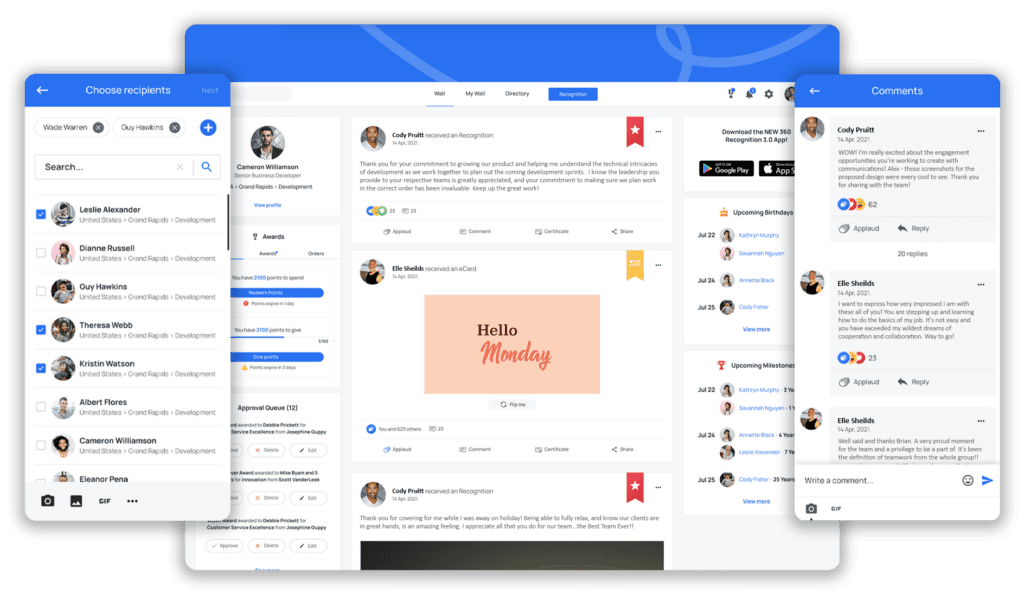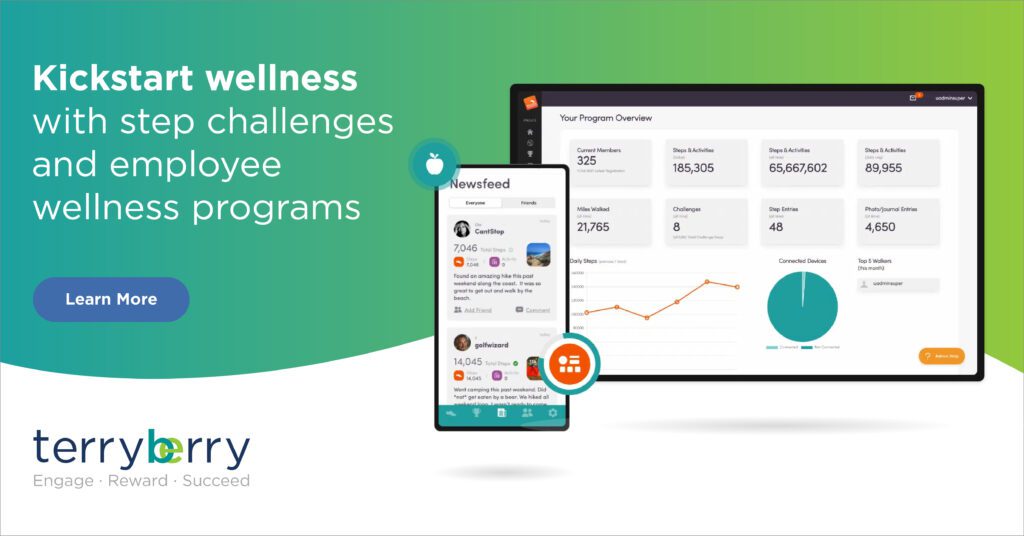March 4, 2024


A positive company culture where employees look forward to coming to work each day and strive to do their best sounds like a dream come true, right?
For organizations that actively engage employees in efforts to raise morale, it's the reality.
As a leader, manager, or HR professional, you have the ability to influence the way that employees view their work and your organization. Learn to identify warning signs of low morale and strategies you can implement to improve your organization's employee morale.
Employee Morale: Meaning and Examples
Employee morale refers to the overall attitude and satisfaction of employees within a company. It's tied to their level of engagement, motivation, and enthusiasm toward their work and colleagues.
High morale is typically accompanied by positive feelings like job satisfaction, a sense of belonging, and a commitment to the overall goals of the company.
Low morale is characterized by negative feelings such as apathy, disengagement, and frustration. In time, low morale can have a detrimental impact on an organization's performance and culture.
Signs of Low Employee Morale
Here are some red flags to watch for when it comes to discerning whether morale is low in your workplace.
Increased Absenteeism
If you notice a rise in absenteeism in the workplace and the number of employees missing work, the behavior could be a result of low employee morale. It's tempting to opt for another sick or mental health day when you don't love what you do or where you work.
Lack of Initiative
An increasing number of employees who are satisfied to stick with bare minimum effort can signal that morale is plummeting. Quiet quitting doesn't just happen because people don't feel like putting in the work. It happens because they feel like their efforts aren't seen or appreciated, so they've lost the motivation to continue taking initiative.
Decreased Productivity
In 2023, the worldwide cost of lost productivity was a staggering $8.8 trillion. Without high morale, employees often don't possess the motivation to complete their work as efficiently as possible.
Unlike the majority of indicators of low morale, productivity is one aspect you can measure. If none of your main processes have changed, yet productivity is tanking, it's time to focus on improving employee morale.
Negative Outlook
Most employees aren't going to outright tell you that they don't like their job or your company, but there may be other indicators that they have a negative view of the workplace.
How do they speak about their co-workers and their clients? Are you getting complaints from customers about their interactions with employees? What do you notice about interactions between various teams?
High Turnover
High employee turnover and low morale are two sides of the same coin. Without the opportunity to invest in employees and build a team of experienced colleagues who trust one another, it can be hard to boost employee morale; with low employee morale, it can be challenging to retain top talent for very long.
Employee burnout and job dissatisfaction don't just happen overnight. They're part of the snowball effect that begins with poor employee morale.
Resistance to Change
A resistance to change is tied to some of the hallmark characteristics of low employee morale: distrust, poor communication, uncertainty, and feelings of fear. Employees may have concerns that a big change will threaten their role or challenge their competence.
Even with high morale, change is intimidating. With low morale, it can feel like a threat to an employee's very being.
Conflict
An occasional disagreement is to be expected in the workplace. However, when conflict becomes commonplace or human resources consistently has to run interference, you may be looking at signs that stress levels are on the rise and staff morale is plummeting.


Factors That Contribute to Low Morale
Workplaces with low employee morale often share a few similar characteristics.
Lack of Recognition and Appreciation
Organizations that fail to celebrate and reward employees are especially susceptible to low morale levels. Employee recognition is a key driver in employee engagement and morale. In fact, employees who don't feel like they've received adequate recognition are twice as likely to quit within the next year.
High Workload and Burnout
An unmanageable workload is the number one driver of burnout and will almost instantly affect employee morale. Almost 70% of workers feel like their company isn't doing enough to prevent burnout.
Poor Leadership
Toxic leadership has a significant impact on job satisfaction and motivation, but it's not just toxic leaders who affect workplace morale. Even well-intentioned managers can cause low morale.
Forbes outlines 12 personal attributes that bad bosses typically share, citing traits such as a lack of empathy, no self-awareness, an attitude of entitlement, poor emotional intelligence, and a reluctance to provide employees with tailored support based on their individual needs.
Poor Communication and a Lack of Transparency
Unclear or inconsistent internal communication creates a disconnect between employees and management. Individuals who feel uninformed or out of the loop lose trust in leadership and the credibility of the organization.
In the absence of clear and transparent communication, employees may resort to rumors and speculation to fill the information void. This is a quick path toward misinformation and distrust among employees.
Limited Opportunities for Growth
With limited prospects for advancement within your organization, employees can feel trapped or stagnant in their current roles.
Motivated individuals become frustrated by a lack of opportunity to develop new skills or take on additional challenges. They will ultimately become less invested in your organization's success and more inclined to seek opportunities elsewhere that offer greater prospects for growth and advancement.


10 Factors that Boost Employee Morale
The consequences of poor morale are staggering, but the good news is that morale is fluid. You can improve employee morale by cultivating a workplace where team members feel like a valued and integral part of your organization
While pizza Fridays or even your occasional efforts to organize team-building activities are fun, they aren't what makes your employees glad to come to work each day.
Here are a few factors to consider prioritizing in your efforts to boost employee morale.
1. Strong Company Culture
Great Place to Work outlines several elements that a good workplace culture involves:
- a credible leadership team
- pride in your job, team, and company
- a feeling of belonging
- effective leadership
- the freedom and safety to pursue innovation
A positive work culture promotes collaboration, innovation, and employee well-being, resulting in a top-notch employee experience and improved organizational success.
2. Work-Life Balance
More than half of employees would accept a lower-paying job in exchange for a better work-life balance, and 33% name a healthy work-life balance as the most crucial factor when choosing a new job.
To encourage a healthy balance:
- set clear expectations regarding work hours, availability, and response times with new employees
- offer time management training and resources
- encourage time off for vacation days, personal data, and sick leave
- ask managers and leadership to lead by example
- schedule regular check-ins with employees to discuss workload and redistribute tasks as necessary
Encouraging employees to establish and enforce clear boundaries between work and home affirms the fact that their employer values them as a person and contributes to increased engagement during working hours.


3. Employee Empowerment
Autonomy is at the heart of employee engagement and morale. The opportunity to make choices for themselves, coupled with the availability of necessary resources, results in employees who take ownership of their work.
Too much interference from leadership communicates that employees don't actually have as much authority as they were initially led to believe, and this micromanaging is a quick path toward poor morale.
Too little involvement, however, results in employees floundering or making decisions that aren't in the best interest of the company mission.
Frequent and inspiring involvement from managers typically hits the sweet spot of employee empowerment.
A few actions set employees up for decision-making success and encourage strong team morale.
Invest in training and coaching to ensure everyone is on the same page. Companies that provide coaching and enable their employees to fail safely are nearly 4 times as likely to be a winning organization.
In addition, clearly outline roles and responsibilities throughout the entire organization. Knowing exactly who is responsible for each decision prevents the delay of murky responsibility where a decision is bounced from one desk to the next.
Getting employee empowerment just right may take some trial and error, but when decisions are made at the right level of an organization (which is most often lower levels of the organization), the company is 6.8 times more likely to be successful.
RELATED: Factors of Empowerment: 4 Ways Leaders Can Empower Their Employees
4. Social Responsibility Initiatives
Social responsibility initiatives emphasize your commitment to making a positive impact on the community in which you operate. This builds an incredible amount of trust and credibility, especially when employees work and reside within the same community.
Improving morale through social responsibility initiatives may look like:
- sustainable production practices
- financial contributions to local charities
- employee volunteer programs
- ethical product sourcing

5. Professional Growth Opportunities
A stagnant work environment where growth is limited and talent development is not actively encouraged will deter top candidates from applying and affect the employee morale of the entire team.
Providing employees the chance to develop new skills or sharpen their strengths communicates your eagerness to invest in their future at your organization. It helps employees feel valued and encourages a longer tenure within the company.
6. Flexible Work Arrangements
A flexible work arrangement impacts employee morale and overall job satisfaction by allowing workers to choose a schedule that's best for them. Some of the most popular options include a compressed or 4-day workweek, hybrid positions, remote work, and flextime.
Current evidence suggests that when people work from home or have the option to do so, employee satisfaction increases by 65%. Having the ability to take time off work without being penalized decreases the likelihood of job-related stress by 56%.
7. Employee Recognition
Consistent employee recognition significantly boosts morale and increases employee satisfaction. 46% of employees have left a job because they felt unappreciated, and employees who feel appreciated are nearly 3 times more likely to be highly engaged.
The most effective recognition includes a mixture of peer-to-peer recognition and top-down recognition, reminding workers that their efforts are seen by people at all levels of the organization.


8. Mentorship or Buddy Program
A strong mentorship program creates high employee morale by building relationships within the workplace and equipping less-experienced employees with the resources they need to thrive in their positions.
Microsoft understands the role that a work buddy plays in workplace morale and pairs new hires with a veteran employee to help them learn the ropes. The company found that when buddies meet at least eight times within the first 90 days of the new employee's ensure, 97% of new hires believe their buddy helped them become productive more quickly.
9. Social Events
Speaking of a buddy program, interpersonal work relationships play a key role in boosting employee morale. Having a best friend at work has been linked to increased productivity, profitability, and employee satisfaction. Instead of asking employees to leave their personal lives at the door, boost morale by creating opportunities to get personal at work.
Social events boost both individual and team morale by providing workers the chance to break out of their routines and get to know their co-workers a little more.
A mixture of regular and unique social events ensures that there's something for everyone. Stick to working hours in order to appeal to the highest number of employees and emphasize your commitment to work-life boundaries.
10. Wellness Programs
A thriving wellness program is one way to ensure that every employee feels like their overall well-being is valued, ultimately improving employee morale.
Choose a wellness program that allows you to support both the physical and mental health of your employees. According to research from the American Psychological Association, 92% of workers feel it's important to them to work for an employer who provides support for employee mental health.
How Can You Evaluate Morale?
While it's tempting to assume you have a finger on the pulse of your organization at all times, the truth is that it can be hard to know how your employees are doing without regular check-ins.
Use a mixture of formal and informal assessments to gauge the overall satisfaction and engagement of your workforce.
Employee Surveys
Using pulse survey software and an anonymous employee engagement survey gathers feedback from employees regarding their current satisfaction levels, work environment, and overall morale.
Use Likert scale employee survey questions to assess how employees feel about different aspects of their employment, such as:
- On a scale of 1 to 5, how satisfied are you with your current job role? (1 - Very Dissatisfied, 2 - Dissatisfied, 3 - Neutral, 4 - Satisfied, 5 - Very Satisfied)
- To what extent do you feel valued and appreciated by your team members and supervisors? (1 - Not at all, 2 - Slightly, 3 - Moderately, 4 - Very, 5 - Extremely)
- How would you rate the effectiveness of communication within the organization? (1 - Very Ineffective, 2 - Ineffective, 3 - Neutral, 4 - Effective, 5 - Very Effective)
- To what degree does your workload align with your skills and abilities? (1 - Not at all, 2 - Slightly, 3 - Moderately, 4 - Very, 5 - Completely)
- How satisfied are you with the opportunities for professional development and growth within the organization? (1 - Very Dissatisfied, 2 - Dissatisfied, 3 - Neutral, 4 - Satisfied, 5 - Very Satisfied)
- How would you rate the level of morale and teamwork among your colleagues? (1 - Very Low, 2 - Low, 3 - Neutral, 4 - High, 5 - Very High)
Open-ended questions allow employees to detail their individual experiences and provide deeper insights into their perceptions and concerns. Potential questions include:
- Can you describe a recent work-related experience that made you feel particularly valued or appreciated?
- What aspects of your job or work environment do you find most motivating and fulfilling?
- Are there any specific challenges or obstacles you've encountered in your work recently that have affected your morale? If so, how do you think they could be addressed?
- What initiatives or changes do you think could boost employee morale and overall job satisfaction within the organization?
Exit Interviews
Exit interviews provide insight into reasons an employee is leaving your organization as well as their overall experience with the company. Look for patterns or common themes related to morale issues that need to be addressed.
Many employees feel they can be more transparent during exit interviews because they don't fear repercussions regarding their feedback-- take advantage of this honesty.
RELATED: Stay Interviews: What are They, Why They’re Important, and 50 Example Questions
Data Analysis
Monitor employee statistics that relate to employee morale, such as absenteeism and turnover rates. Over time, trends in the data may reveal areas where you need to focus on boosting morale.
For example, you may notice that one specific team has higher absentee rates than everyone else or that your employee retention has taken a nosedive. Honing in on these areas will help you breathe new life into the overall company morale.
Boosting Employee Morale is a Team Effort
Maintaining employee morale takes consistent and concentrated effort-- something that can be hard to sustain long-term.
Industry leaders like Ford, Unilever, and Little Ceaser's understand the value of using employee recognition software to cultivate a culture of appreciation and boost employee morale.
We're ready to help you design a tailored recognition program that meets your organization's specific needs, transforming individual talent into teams.
Schedule a demo to see what Terryberry can do for your company culture.




